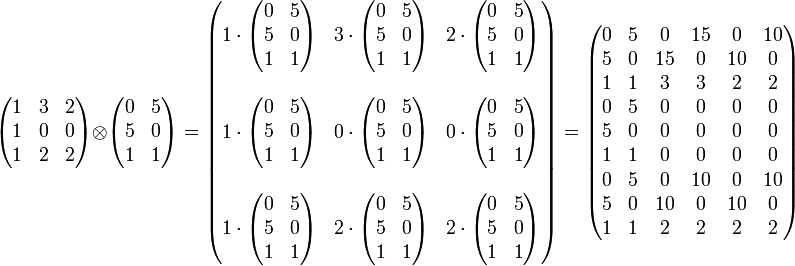- Kroneckerprodukt
-
Das Kronecker-Produkt (nach Leopold Kronecker) ist ein Begriff aus der Matrizenrechnung.
Inhaltsverzeichnis
Definition
Ist A eine
 Matrix und B eine
Matrix und B eine  Matrix so ist das Kronecker-Produkt
Matrix so ist das Kronecker-Produkt  definiert als
definiert alsDas heißt jedes Element der Matrix A wird mit der Matrix B multipliziert. Das Ergebnis ist also wieder eine Matrix, allerdings von der Dimension
 .
.1. Beispiel
2. Beispiel
Eigenschaften
Das Kronecker-Produkt ist nicht kommutativ. Das heißt im Allgemeinen gilt
Es gibt jedoch Permutationsmatrizen P,Q so dass gilt
Sind dabei A und B quadratisch so kann P = QT gewählt werden.
Das Kronecker-Produkt ist bilinear. Das heißt
Das Kronecker-Produkt ist assoziativ. Das heißt
Für die Transposition gilt
 .
.
Sind A und B quadratische Matrizen so gilt für die Spur
 .
.
Für den Rang gilt
 .
.
Ist A eine
 und B eine
und B eine  Matrix so gilt für die Determinante
Matrix so gilt für die Determinante .
.
Sind
 die Eigenwerte von A und
die Eigenwerte von A und  die Eigenwerte von B dann gilt
die Eigenwerte von B dann gilt sind die Eigenwerte von
sind die Eigenwerte von  .
.
Sind A,B invertierbar so ist
 .
.
Sind die (komplexen) Matrizen A,B,C und D mit den Dimensionen
gegeben, so gilt [1]
 .
.
Matrixgleichung
Es seien die Matrizen
 gegeben
gegebenund eine Matrix
 gesucht so dass
gesucht so dass  gilt. Nun gilt folgende Äquivalenz:
gilt. Nun gilt folgende Äquivalenz:Hierbei steht
 für die spaltenweise Vektorisierung einer Matrix zu einem Spaltenvektor.
für die spaltenweise Vektorisierung einer Matrix zu einem Spaltenvektor.Sind
 die Spalten der Matrix
die Spalten der Matrix  so ist
so ist  ein Spaltenvektor der Länge
ein Spaltenvektor der Länge  .
.Analog ist
 ein Spaltenvektor der Länge
ein Spaltenvektor der Länge  .
.Hat man den Vektor
 ermittelt so ergibt sich daraus unmittelbar die zugehörige, isomorphe Matrix
ermittelt so ergibt sich daraus unmittelbar die zugehörige, isomorphe Matrix  .
.Beweis der Äquivalenz
Es ist

Dabei ist

Gleichungssystem mit Matrixkoeffizienten
Für
 und
und  seien die Matrizen
seien die Matrizen  gegeben.
gegeben.Gesucht sind die Matrizen
 , welche das Gleichungssystem
, welche das Gleichungssystemlösen. Diese Aufgabenstellung ist äquivalent zum Lösen des Gleichungssystems
Weitere Anwendungen
Das Kronecker-Produkt wird beispielsweise in der verallgemeinerten linearen Regressionsanalyse verwendet, um eine Kovarianzmatrix von korrelierten Störgrößen zu konstruieren. Man erhält hier etwa eine blockdiagonale Zellnermatrix.
Zudem braucht man das Kronecker-Produkt in der Quantenmechanik um Systeme mit mehreren Teilchen, die ein beidseitig beschränktes Spektrum besitzen, zu beschreiben. Zustände mehrerer Teilchen sind dann Kroneckerprodukte der Einteilchenzustände. Im Falle eines unbeschränkten Spektrums bleibt nur die algebraische Struktur eines Kronecker-Produktes erhalten, da dann keine Darstellung durch Matrizen existiert.
Zusammenhang mit Tensorprodukten
Gegeben seien zwei lineare Abbildungen
 und
und  zwischen endlich dimensionalen Vektorräumen. Dann gibt es immer genau eine lineare Abbildung
zwischen endlich dimensionalen Vektorräumen. Dann gibt es immer genau eine lineare Abbildungzwischen den Tensorprodukten mit
 .
.Wenn wir auf den Vektorräumen V1,W1,V2 und W2 je eine Basis auswählen, so können wir der Abbildung
 ihre Darstellungsmatrix A zuordnen, B sei die Darstellungsmatrix von
ihre Darstellungsmatrix A zuordnen, B sei die Darstellungsmatrix von  . Das Kronecker-Produkt
. Das Kronecker-Produkt  der Darstellungsmatrizen ist nun genau die Darstellungsmatrix der tensorierten Abbildung
der Darstellungsmatrizen ist nun genau die Darstellungsmatrix der tensorierten Abbildung  .
.Damit dies funktioniert, müssen aber die Basen auf
 und
und  richtig gewählt werden: Wenn
richtig gewählt werden: Wenn  die ausgewählte Basis von V1 und
die ausgewählte Basis von V1 und  die Basis von V2 gegeben ist, so nehmen wir
die Basis von V2 gegeben ist, so nehmen wir  als Basis für das Tensorprodukt
als Basis für das Tensorprodukt  . Analog für
. Analog für  .
.Historisches
Das Kronecker-Produkt ist nach Leopold Kronecker benannt, weil er es anscheinend als erster definierte und verwendete. Früher wurde das Kronecker-Produkt manchmal Zehfuss-Matrix genannt, nach Johann Georg Zehfuss.
Weblinks
Quellen
- ↑ Steeb, Willi Hans: Kronecker Product of Matrices and Applications. BI-Wiss.Verlag, 1991, ISBN 3-411-14811-X, S.16
Wikimedia Foundation.

















